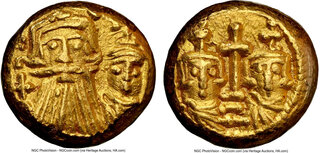| Heritage World Coin Auctions > Showcase Auction 61386 | Auction date: 21 April 2024 |
| Lot number: 24125 Price realized: 600 USD (Approx. 563 EUR) Note: Prices do not include buyer's fees. | Show similar lots on CoinArchives Find similar lots in upcoming auctions on |
| Lot description: Ancients Constans II Pogonatus with Constantine IV, Heraclius, and Tiberius (AD 659-668). AV solidus (11mm, 4.51 gm, 6h). NGC Choice XF 4/5 - 4/5. Carthage, AD 659-668. Facing draped busts of Constans II (on left), with long mustache and beard, with globus cruciger in right hand, and Constantine (on right), beardless, each wearing crown surmounted by cross / Facing draped busts of Heraclius and Tiberius, both wearing crowns surmounted by cross, and globus cruciger in right hand, flanking cross with base on two steps. Sear 1044. The thick and compact shape of the globular solidus is amusing and remarkable to us now, but it must have not been that way for the people of Late Antiquity as there are no specific mentions of these coins in any contemporary historical sources. Upon closer inspection, it would seem that the globular solidi were wholly unique issues of the Byzantine Maghreb under the Heraclian dynasty. Carthage was the capital of the Exarchate of Africa and the location of the second largest gold mint in the Byzantine Empire, proving vital to the success of the one hundred year reign of the Heraclian imperial dynasty at Constantinople. Massive wars were fought between the Byzantine Empire and its invading neighbors--consisting of many conquests, losses, and reconquests--splitting the land and sea connections between the various imperial provinces. Two dates in the seventh century mark the bifurcation of the Mediterranean gold bullion supply chain for the Carthage mint: the Visigothic conquest of remaining Byzantine territory on the southern Iberian Peninsula by 625 AD (which concluded Carthage's access to its largest nearby gold mines) and the closure of the mint of Alexandria by the Umayyads in 646 AD (the only other imperial mint in Africa, also near large gold mines). A new trade route for gold supply must have been sought with geographic distance from the Byzantine Empire's competitors to the northwest and the east. Renowned archaeologist David W. Phillipson has published the main hypothesis for the shape of the globular solidus, based on fascinating recent discoveries which he examines in his article "Trans-Saharan gold trade and Byzantine coinage", The Antiquaries Journal, Vol. 97 (21 December 2017). Clay molds for the smelting of gold pellets weighing exactly 4.50 grams--the weight of the Byzantine solidus--were excavated at an eighth century archaeological site in Tadmekka (modern Essouk, Mali), a site located on the well-travelled Saharan caravan route between the trading hubs of Timbuktu, Gao, and the mint/port at Carthage. The gold trade likely existed there before its mention in early Islamic sources, where it would have been facilitated by the Berbers who inhabited both the Exarchate of Africa and the cities of the Sahara Desert. The globular solidus' shape could have been derived from these cast solidus-weighted gold spheres from West Africa. More research still needs to be done on this subject, such as metallurgical studies of the ore content of these coins compared to gold from the Niger and Senegal river Basins, as well as excavations of sites in Mali. https://coins.ha.com/itm/ancients/byzantine/ancients-constans-ii-pogonatus-with-constantine-iv-heraclius-and-tiberius-ad-659-668-av-solidus-11mm-451-gm-/a/61386-24125.s?type=DA-DMC-CoinArchives-WorldCoins-61386-04212024 HID02906262019 © 2024 Heritage Auctions | All Rights Reserved |  |



